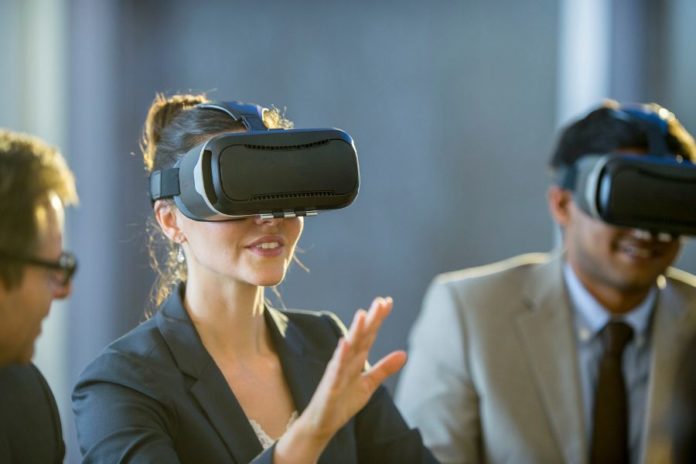
As the technology improves and becomes more accessible, virtual reality has been making its way into new aspects of life and work in recent years. One area that has been benefiting from the tech is learning and development as well as training for new hires. From providing an immersive learning experience to reducing training barriers, here are insights from executives and HR leaders on ways VR can be used for training.
Provide an Immersive Learning Experience
Virtual reality (VR) is a powerful tool that can be used to solve training problems and create a more efficient and effective learning experience for employees. One way that VR can be used to solve training problems is through immersive learning experiences. By using a virtual environment, employees can interact with their environment in a realistic manner, allowing them to learn and practice new skills without the need for physical materials or resources.
For example, a company that manufactures complex aircraft engines could use virtual reality to provide their employees with a realistic simulation of the engine assembly process. In this way, employees can practice different assembly methods, become familiar with the parts and understand how the engine works without having to actually assemble a physical engine. This immersive learning experience allows employees to learn the necessary skills and procedures more quickly and efficiently.
Janie Doyle
Marketing Director, Scvehiclehire
Make Mistakes Without Real-Life Consequences
Virtual Reality (VR) has been used in various industries to solve training problems in a more effective and immersive way. One such example is in the medical field, where VR provides a safe and controlled environment for medical students and professionals to practice complex procedures and surgeries.
With VR, students can get hands-on experience in a simulated environment, where they can make mistakes and learn from them without any real-life consequences. This enhances their skills and knowledge and allows them to be better prepared for real-life scenarios.
By using VR, medical training programs can provide a more interactive and engaging experience, leading to improved outcomes and increased patient safety.
Cynthia Hamilton
Marketing Director, Oglf
Decrease Incident Costs
Virtual reality has become a valuable tool for businesses. It is widely used in training programs. This technology has decreased incident costs for training. Employees can learn critical job skills in a realistic environment. They can learn situational and spatial awareness, but fewer incidents will take place — which will decrease the cost. For example, food processor-trained employees also work in a safe environment because of VR training. You may find it shocking, but due to VR training, some studies found that around 90% of employees felt more prepared to deal with safety hazards. It amazingly reduced the incident costs that used to take place in the sites of manufacturing and others.
Sanjay Singh
Founder and CEO, Technource Inc.
Provide a Safe Environment for High-risk Occupations
One way that virtual reality (VR) has solved a training problem is by providing a safe and immersive environment for training individuals in high-risk or dangerous situations. For example, firefighters often face life-threatening situations while on the job, and traditional training methods may not adequately prepare them for these situations. However, VR technology can create realistic simulations of different fire scenarios that allow firefighters to practice their skills and decision-making in a controlled environment.
VR training programs can also provide immediate feedback to trainees, allowing them to adjust their behavior and decision-making in real time. This training can improve the effectiveness and safety of firefighters on the job and potentially save lives. Overall, virtual reality has the potential to revolutionize training by providing a safe, immersive and interactive learning experience that traditional methods cannot replicate.
Jason Moss
President and Co-Founder, Moss Technologies
By Helping to Conceptualize Abstract Concepts
One major limitation of most conventional training methods is the inability to provide a detailed and immersive training environment. Most of the old methods failed to account for the individual needs of the end-users, especially when the use case involved introducing abstract concepts to new employees.
For example, we were recently faced with a challenge – we needed to introduce fresh employees to certain new and cognitively demanding concepts. During the course of the exercise, we realized that field training would be our only option if we wanted our new team to grasp the operational details quicker and better. But the problem was; due to time constraints and cost implications, this was going to be impossible.
However, after some research, we found several readily-available VR-based training materials. These not only saved our organization some cost but also catered to our employees on an individual level, creating the immersive environment we so desperately needed.
AJAYI Ayomide
Growth Marketer and Writer, Howsociable
Cultivate a Safe and Realistic Environment
The medical field is one area in which virtual reality has solved a training problem. For example, the US Army has created a medical simulation program that allows medical personnel to practice treating trauma patients in a safe and controlled environment. This program has allowed the Army to reduce training time and costs while ensuring that their personnel is prepared to handle any situation they may encounter in a real-life medical emergency.
Michael Chen
Growth Director, Notta
Reduce Training Barriers
One problem with training individuals is scheduling and travel. For example, a business might want to train all of their employees on a topic within a three-month period, however, there is only one course available in the area during this time frame and not all employees can go at once due to business needs. Virtual reality has helped solve this problem by offering on-demand access to training, which allows for more flexibility for employers and individuals. It also reduces any inconvenience generated by traveling to training locations.
Will Baker
Founder, Skirtings R Us













